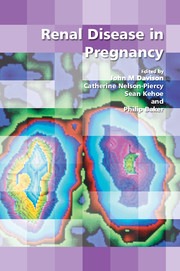Book contents
- Frontmatter
- Contents
- Participants
- Preface
- SECTION 1 RENAL PHYSIOLOGY IN PREGNANCY
- SECTION 2 PATTERNS OF CARE
- SECTION 3 CHRONIC KIDNEY DISEASE
- 6 Pregnancy and dialysis
- 7 Pregnancy and the renal transplant recipient
- 8 Reflux nephropathy in pregnancy
- 9 Lupus and connective tissue disease in pregnancy
- 10 Diabetic nephropathy in pregnancy
- SECTION 4 DRUGS USED IN RENAL DISEASE IN PREGNANCY
- SECTION 5 ACUTE RENAL IMPAIRMENT
- SECTION 6 UROLOGY AND PREGNANCY
- SECTION 7 SURGICAL AND MEDICAL ISSUES SPECIFIC TO RENAL TRANSPLANT PATIENTS
- SECTION 8 CONSENSUS VIEWS
- Index
8 - Reflux nephropathy in pregnancy
from SECTION 3 - CHRONIC KIDNEY DISEASE
Published online by Cambridge University Press: 05 September 2014
- Frontmatter
- Contents
- Participants
- Preface
- SECTION 1 RENAL PHYSIOLOGY IN PREGNANCY
- SECTION 2 PATTERNS OF CARE
- SECTION 3 CHRONIC KIDNEY DISEASE
- 6 Pregnancy and dialysis
- 7 Pregnancy and the renal transplant recipient
- 8 Reflux nephropathy in pregnancy
- 9 Lupus and connective tissue disease in pregnancy
- 10 Diabetic nephropathy in pregnancy
- SECTION 4 DRUGS USED IN RENAL DISEASE IN PREGNANCY
- SECTION 5 ACUTE RENAL IMPAIRMENT
- SECTION 6 UROLOGY AND PREGNANCY
- SECTION 7 SURGICAL AND MEDICAL ISSUES SPECIFIC TO RENAL TRANSPLANT PATIENTS
- SECTION 8 CONSENSUS VIEWS
- Index
Summary
Vesicoureteric reflux and reflux nephropathy: epidemiology, pathogenesis and clinical features
One-third of all anomalies detected by routine fetal ultrasonography are congenital abnormalities of the kidney and urinary tract (CAKUT). The spectrum of abnormalities seen in individuals with CAKUT is wide and includes ureteric abnormalities (e.g. vesicoureteric reflux (VUR), megaureter and ureterovesical junction obstruction) and kidney abnormalities (e.g. aplastic kidneys, multicystic dysplasic kidneys, hydronephrosis and duplex kidney).
In clinical practice, VUR is the most common manifestation of CAKUT with an incidence in the general population from at least 0.4% to 1.8%. Primary VUR results in the retrograde passage of urine from the bladder through the ureter into the upper urinary tract. In the majority, VUR resolves with time and is most often manifest in childhood. There is now clear recognition that this has a familial component. Early segregation analysis pointed to a single dominant gene but more recent evidence points to a polygenic genetically heterogeneous trait with multiple candidate genes affecting males and females equally.
Reflux nephropathy is a term that describes coarse unilateral or bilateral renal scarring often found in association with VUR, an appearance previously known as chronic pyelonephritis. However, only a proportion of children with VUR subsequently develop reflux nephropathy. Under the age of 8 years, 26% of children diagnosed with VUR have renal scars, whereas in children 8 years or older 47% have renal scars at the time of diagnosis of VUR. Reflux nephropathy is the most common cause of end-stage renal disease (ESRD) in children and accounts for 10% of all ESRD.
- Type
- Chapter
- Information
- Renal Disease in Pregnancy , pp. 89 - 94Publisher: Cambridge University PressPrint publication year: 2008

